|
|
|
|
Interiors of town Roman-Catholic church and a restorant Golden Peacock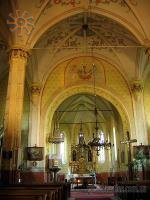 |
For me, when I go abroad, the feeling that I am in a foreign Land comes not because of architecture that looks different from my native place, or because people in the streets look different, but through the signs on the stores and the language I hear spoken around me. When I went to the town of Beregovo, a regional centre in Zakarpatska Oblast (Transcarpathian Region), Ukraine.. I experienced a strange feeling that I was abroad, though I had not crossed the Ukrainian border. 
The locals often call their town Beregsas, the it used to be called before it was renamed Beregovo. In 1991, Beregovo Rayon (in Ukraine, rayon is an administrative division of a larger administrative unit, Oblast) was given the status of a Hungarian autonomous enclave. The signs are written in Hungarian and Ukrainian; in some cases, those who wrote the signs were evidently not .sure what the proper Ukrainian idiom should be used, and resolved the problem by using the simplest words they could think of. There are two state flags hoisted above the building of the municipal council — the Hungarian and Ukrainian ones. On the doors of shops, cafes and restaurants I saw an abbreviation, za K.Ch.., which followed the figures indicating the time the place was open. It was explained to me that the abbreviation stood “za kyivskym chasom”, that is "Kiev time." 
Most of the memorial plaques I saw had the Hungarian state symbol on them which indicated that these plaques were put up in commemoration of someone Hungarian. The biggest church in town is not Orthodox but Lutheran. It took me some time to get adjusted to the fact that even such familiar words as Shevchenko, for example, in the names of places or institutions, looked exotic - Sevscenko.
The people of Beregovo are friendly and smiling, but it was difficult to make myself understood when I stopped someone the street asking for directions. I did feel as though it was Hungary rather than in Ukraine. I was reminded I was still Ukraine came when on the day when the 175th Anniversary of Shevchcnko's birth was marked - I saw a local school adorned with flower garlands and with a big portrait of the great Ukrainian poet.
Walking through the streets of Beregovo In the spring, with cherry trees, magnolias, horse chest nuts and lilacs in full blossom was a pleasure indeed. The air was permeated with fragrances of blossoms, and the eyes feasted on the blooms. But I wanted to have a better look at the life in Beregovo, and sec something else in addition to Hungarian letters and nature in. bloom. 
For many Ukrainians, the word Beregove evoces associations with a brand of wine. There is, indeed, a winery situated in a suburb of Bcregove, in the former residence of Count Schonborn. The Count must have been romantically inclined - his estates were situated in very picturesque places, the one in Beregovo being particularly scenic.
The winery looks like a medieval castle the way it is shown in pictures in books of fairy tales, rather than like a place that makes wine. A cozy garden around it only enhances this impression. But my attempt to get a closer look failed - you have to have a very good official reason to be admitted.
But I was not put off by my failure. There is a great deal of other landmarks from the times long past in Beregovo that are worth seeing, some of them dating to very early medieval times. The church in the central square of town was built in the 12th century, at least the very core of it.
There is a local legend that says that it was a shepherd, named Sas, who gave the money - or rather gold - for the construction of the church. The story goes like this:
Once, Sas had to look after bulls that were very belligerent and seemed to be intent on engaging him in bull fights. During one of such amateur bull fights, he accidentally discovered a pot filled with gold coins in a cache revealed by the hooves of the bulls which churned the ground right at the site where the church now stands. The lucky shepherd supposedly donated the gold to a fund to have a church built. Around the church, a town grew up, later to be named Beregsas (a river bank + Sas). 
A memoriai plaque on the facade of the same church tells a different story. The inscription says that it was Duke Lampert, the younger son of King Bela, who was the founder of the settlement which later became the town of Baragsas. In 1141, another king, Geza II, invited Saxons to come from their Saxony and settle down in the town that was subjected to frequent raids of the nomads. The king hoped that the sturdy Saxons would be able to deal with the annoying invaders much better and would put the invaders off.
The town then acquired the name of Lampertsas, or Sas. In 1241, the invading Mongols took the town and levelled it to the ground, the central church included. In 1370 the church was rebuilt in the Gothic style which was then prevalent all over Europe, in 1839, a major reconstruction changed the appearance of the church to a large extent but did not alter it completely.
In front of the church stands a bronze bust of a Hungarian king, Istvan the Saint, and close to it, there is another monument, to a Hungarian poet named Sandor Petefi who looks rather like a boy than a grown-up man. Behind the church I discovered a place which is called The Count's Yard - a former estate of Count Gabor Betleni from Transylvania. The central building of the estate, which is now a local museum, dates from the early seventeenth century. 
Probably the best restaurant in Beregovo is The Golden Peacock whose interior is carefully stylized to correspond to the exterior of the house it is situated in. The house bears evident signs of what used to be called "Style Modern" or Art Nouveau. The stage in the restaurant looks like a stylized peacock tail; lamps are stylized to look like birds, and the whole place is adorned with bunches of peacock feathers; big mirrors and magnificent divans add to the place's chic. I found salads they serve at The Golden Peacock to be particularly good and the prices amazingly low.
Among the places I went to in Beregovo was the sports club Zakarpattia which boasts a gym, a sauna bath and a swimming pool filled with mineral water. The water comes from a well, 1,680 meters deep.
A must is a visit to Koshuta Square with its two-story houses that look like toys and a huge building of what used to be an imperial court (when it was built, in 1908, Hungary was a coastituent part of the Austrian-Hungarian Empire). The architect Ferenz Yablonsky evidently liked everything large-sized. One of the grand halls of the immense building was designed to serve as a place for fencing.
Square of Heroes which is situated close by, sports a seventcenth-century hotel, Oroslan, the first hotel ever built in Beregovo, and a Hungarian folk theater. Quiet streets radiating from the square, are lined up with nineteenth-century mansions, and several high-rises among them look out of place in this place frozen in the past. There is always a nostalgic note in thinking about the past and I felt I wanted to go back to Beregovo, a gemutlich town surrounded by mountains, soon after I left it. 
|
|

|

 |
 |
 |
 |
 |
Hungarian is everywhere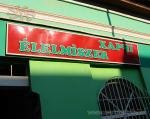 |
Two flags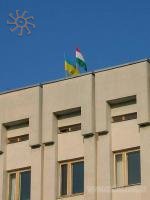 |
In the centre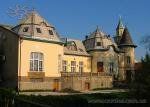 |
But we are in Ukraine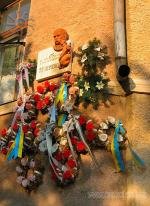 |
Istvan the Saint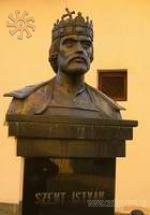 |
Korzo in the evening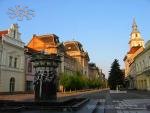 |
The Count's Yard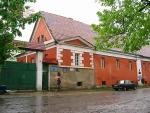 |
Museum in The Count's Yard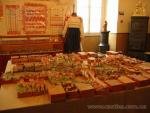 |
Hungarian Theatre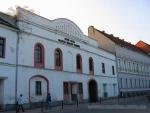 |
Ukrainian Gymnasium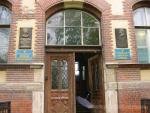 |
The winery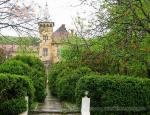 |
Lutheranian church is the biggest in the town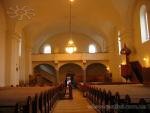 |
|
 |
 |
 |
 |
 |
 |
 |
 |
|
|

